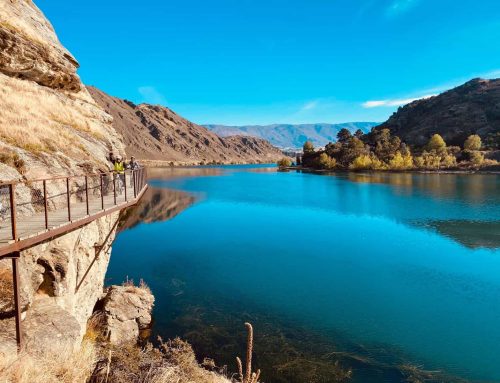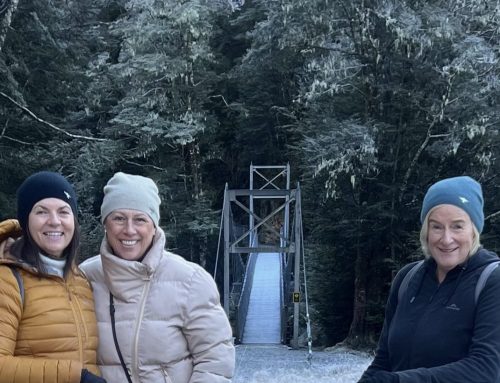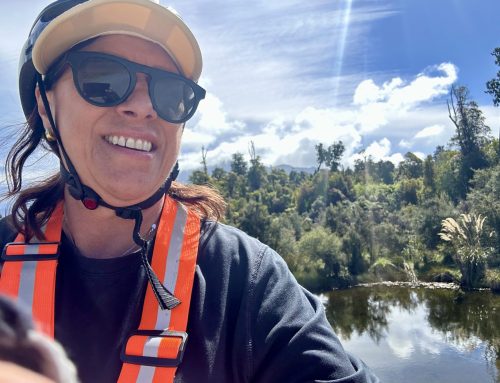Another great outdoor activity to do post lockdown is bike Central Otago’s Rail Trail.

Arriving into Hyde for our first night.
I did it a couple of years ago with my sister and I’d highly recommend it. The 150- kilometre bike track is on what was the old railway line through Central Otago’s heartland. We did it over five days, cycling about 30 kilometres a day. All the train tracks have been removed, but many of the old railway stations are still intact.
If you’re worried about hills, there aren’t any. Trains don’t go up hills, they only go up gradual inclines so it’s very manageable. Plus, the trail is wide with plenty of room should cyclists becoming the other way.

This diagram shows the incline. Note, we started in Middlemarch and ended Clyde which is possibly a gentler gradient.
A little history about the Otago Central Rail Trail
Construction of the railway began in 1879 to provide transport from Dunedin to the Central Otago towns. It took 28 years to build and was finished in 1907, carrying freight as well as passengers.
For many years the government regulations protected the railway from the competition, by placing restrictions on the distances goods could be carried by road. However, in 1983 this all ended and the closing of the railway became inevitable. They kept the lines open to service the construction of the Clyde Dam, but once it was completed in 1990 the line was closed and the tracks removed.

The Clyde Dam.
The Department of Conservation acquired the 150km corridor from Middlemarch to Clyde in 1993. They spent six years developing it for walker, cyclists and horse riders and renamed it the Central Otago Rail Trail.
Our adventure started at Dunedin Railway Station
Our adventure started at Dunedin Railway Station, fondly known as the ‘Our Ginger Bread House.’ Architect, Mr George Troup designed the large station in a grandiose style with rich eccentric embellishments which earned him the nickname, ‘Gingerbread George.’

Dunedin’s Railway Station.
The railway station is seen as the jewel of the crown of railway stations in New Zealand and was opened in 1906. At the time, Dunedin was the largest commercial centre in New Zealand so a railway station of this magnitude seemed fitting.
Taieri Gorge Railway
Boarding the Taieri Gorge Railway our journey began. The bright yellow train, with all the charm of yesteryear took us to Pukerangi, the end of the line. From there it’s about a 20-minute ride to Middlemarch, the beginning of the trail.

Taieri Gorge Railway.
As we pulled away from the station, a Southern man, rolling his ‘r’s started a very informative commentary about the railway. We followed the Taieri River travelling over the impressive Wingatui Viaduct, through the Taieri Plains and the Salisbury Tunnel.

The Wingatui Viaduct
Day 1 – Middlemarch to Hyde
Before I go any further I need to tell you we booked the Rail Trail through Trail Journeys. They were excellent, but more on that at the end of the blog.
So, having arrived in Middlemarch we were fitted with bikes at the Trail Journey depot and headed off into the sunset riding through beautiful countryside. The ride took us about two hours, covering 28 kilometres to our first night’s accommodation.

Leaving Middlemarch on our first day of cycling.
The Department of Conservation has great huts along the way with information about the area. One of the fascinating, but tragic pieces of information was a train disaster in 1893. The train driver approached a bend going 120 km, twice the recommended speed de-railing all seven carriages, killing 21 people.
Arriving into Hyde we were welcomed at Hyde Lodge by our host, Sarah. With no-where else to eat in the town, we had pre-ordered our dinner. Sarah delivering a delicious salmon entrée and lamb shank to our cottage. Well satisfied we crawled off to bed in anticipation of another great day.
Day 2 -Hyde to Ranfurly
Settling off from our cottage we cycled through more beautiful Central Otago farmland. The highlights were the Price Creek Viaduct, 32-metre high followed by the Price’s Creek tunnel.

Hyde’s old pub.

Heading into Prices Creek tunnel…a torch is a useful addition.
We arrived in Ranfurly in plenty of time to head up to nearby Naseby and try our hand at curling. The town is famous for its curling with indoor and outdoor rings.

Curling takes more skill than it looks!
Accommodation at the Hawdun Lodge was excellent and within walking distance of the Ranfurly Hotel for dinner. However, the Ancient British restaurant in Naseby is the place to eat. Apparently, it recently won a lamb award for its slow-cooked, seared shoulder.
Day 3 – Ranfurly to Oturehua
The highest point of the trail was on this section of the track, 618 metres above sea level. However, I can’t stress enough how gradual the gradient is. We rode through green pastures with contented, clean white sheep so well fed they were relaxing in the sun.

This is a typical uphill gradient.
We stopped for coffee at Wedderburn before continued on our way to Oturehua for lunch. Staying at the Inverlair Lodge we ate at the local tavern, enjoyed a bit of banter and pool with the locals.
Just two kilometres from Oturehua is Hayes Engineering Works. It was here Ernest Hayes invented the world-famous wire strainer and the cattle stop. With 10 children, his wife Hannah left their 12-year old daughter in charge of the younger siblings as she rode hundreds of miles throughout Central Otago selling their tools. The workshop is a sight to behold, with everything still intact.

Hayes Engineering workshop needs to be seen. The family story is inspirational.
Also in the town, is Gilchrist’s Store with its 1899 interior and original merchandise on the shelves. Definitely worth a look.
Day 4 – Oturehua to Ophir
Leaving the warmth of the lodge we were pleased we had our thermals, hat and gloves as the temperature had dropped significantly from the previous days. We passed through the Ida Valley and the Poolburn Gorge Tunnels.

From Omakau the pretty township of Ophir is just two kilometres away. We stayed at Blacks Hotel, recently taken over by two couples from the UK who have successfully turned it into a warm and welcoming pub.
Day 5 – Ophir to Clyde

Stunning autumn colours were starting to appear.
As we rode closer to Alexandra the popular and willow trees became more spectacular with the turning leaves.
In Alexandra, we opted to take a cruise on the Clutha River despite the chilling wind. Our driver and guide gave us a fascinating commentary of the gold rush in the 1860s pointing out many of the gold miner’s homes. Built into the schist rock they created caves with fireplaces, but I have no idea how they managed to keep warm in the chilling winters months.

Can you spot the small square window on the left of the photo? This is one of the miner’s houses.

All rugged up for our trip down the Clutha River.
The final town was Clyde. Don’t miss out on the historic settlement and if you have time eat at Oliver’s or Paulina’s. The Dunstan Hotel is a great example of what it was like in the late 1880s. At the far end of the town is a lookout where you can get a great view of the Clyde Dam, New Zealand’s third-largest hydropower station.
From Clyde, it’s a little over an hour, by road back to Queenstown. Read more from Blog the Globe about Otago Central highlights.
Q & A
Who should I book with to do the Otago Central Rail Trail?
There are a number of companies offering this service. I choose Trail Journeys as it was recommended by a friend and they were fantastic.
They organised every aspect of our trip from your train ticket, transfers, accommodation, luggage transfers to your next destination, activities like curling in Naseby and the Clutha River Cruise and of course our bikes. I’d have to say they were excellent to deal with and our five-days on the rail trail were seamless with everything going to plan.
They sent out a detailed itinerary and a lot of information about what to expect, what to pack, where to book your evening meals and other useful information.
Which is the best way to cycle the Otago Central Rail Trail?
We started in Dunedin and ended up in Clyde, however, most people were cycling in the other direction. It really comes down to personal preference.
What’s the best time of year to do the Otago Central Rail Trail?
Summer, although January can be very hot. After April I imagine it would be very cold.
Should I get an e-bike?
I opted for an e-bike as a result of a recent knee injury, but I barely used it. However, when there where strong headwinds a little boost of power made all the difference. If you are a little unsure of your fitness or could be the ‘weakest link’ in a group of fitness freaks, get one however they do cost more than a regular bike.
For more information on the Otago Central Rail Trail






Leave A Comment